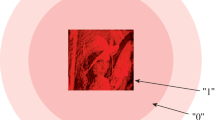Abstract
Computer-generated binary holograms are written on a polished copper surface using single 800-nm, 120-fs pulses from a 1-kHz-repetition-rate laser system. The hologram efficiency (i.e. the power in the holographic reconstructed image relative to the incoming laser power) is investigated for different laser-structuring parameters. Theoretical diffraction grating efficiencies for a binary amplitude grating show good agreement with the experimental measurements for diameters of the laser-formed holes below the pitch. Modelling based on straightforward geometrical arguments is used to find the optimal hole size. For a coverage (i.e. relative laser-structured area) of ∼43 %, the efficiency reaches ∼10 %, which corresponds to a relative power transferred to one reconstructed image of ∼20 %. The efficiency as a function of pitch (for fixed coverage) is fairly constant from 2 to 6 μm.




Similar content being viewed by others
References
A.W. Lohmann, D.P. Paris, Appl. Opt. 6, 1739 (1967)
P. Harihan, Optical Holography, Principles, Techniques, and Applications, 2nd ed. (Cambridge University Press, New York, 1996)
O. Bryngdahl, F. Wyrowski, in I Digital Holography—Computer-Generated Holograms in Progress in Optics 28, ed. by E. Wolf (Elsevier, Amsterdam, 1990)
K.J. Waedegaard, P. Balling, Opt. Express 19, 3434 (2011)
Y. Li, Y. Dou, R. An, H. Yang, Q. Gong, Opt. Express 13, 2433 (2005)
Q.-Z. Zhao, J.-R. Qiu, X.-W. Jiang, E.-W. Dai, C.-H. Zhou, C.-S. Zhu, Opt. Express 13, 2089 (2005)
D. Buerle, Laser Processing and Chemistry, 4th ed. (Springer, Berlin, 2011)
P. Balling, chapter 14 in Laser Cleaning II, ed. D. M. Kane (World Scientific Publishing, Singapore 2006)
Z. Guo, S. Qu, S. Liu, Opt. Commun. 273, 286 (2007)
Y. Li, W. Watanabe, K. Itoh, X. Sun, Appl. Phys. Lett. 81, 1952 (2002)
R.S. Taylor, C. Hnatovsky, E. Simova, P.P. Rajeev, D.M. Rayner, P.B. Corkurn, Opt. Lett. 32, 2888 (2007)
A. Martínez, M.d.M. Sánchez-López, I. Moreno, Eur. J. Phys. 28, 805 (2007)
G.K. Ackermann, J. Eichler, Holography, A Practical Approach. (Wiley-VCH Verlag GmbH, Weinheim, 2007)
K. Zhou, Z. Guo, W. Ding, S. Liu, Opt. Express 18, 13640 (2010)
de T.M. Jong, de D.K.G. Boer, C.W.M. Bastiaansen, Opt. Express 19, 15127 (2011)
Acknowledgments
This work was supported by The Danish Council for Independent Research | Natural Sciences (FNU).
Author information
Authors and Affiliations
Corresponding author
Rights and permissions
About this article
Cite this article
Wædegaard, K.J., Hansen, H.D. & Balling, P. Optimizing the efficiency of femtosecond-laser-written holograms. Appl. Phys. B 113, 345–349 (2013). https://doi.org/10.1007/s00340-013-5496-0
Published:
Issue Date:
DOI: https://doi.org/10.1007/s00340-013-5496-0




